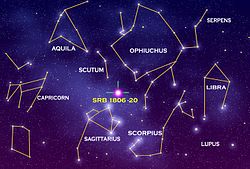SGR 1806−20
| Observation data EpochJ2000EquinoxJ2000 | |
|---|---|
| Constellation | Sagittarius |
| Right ascension | 18h 08m 39.32s |
| Declination | −20° 24' 39.5 "' |
| Apparent magnitude(V) | totally obscured |
| Astrometry | |
| Distance | 42,000ly (13,000[1]pc) |
| Details | |
| Rotation | 7.55592s[1] |
| Other designations | |
GRB790107,INTEGRAL184,AX 1805.7-2025 GRB 970912,INTREF882,CXOUJ180839.3-202439,HETE Trigger1566, KONUS 07.01.79, EQ 1805.7-2025,HETE Trigger3801,PSRJ1808−2024,GBS1806-20,HETE Trigger3800,RXJ1808.6−2024 | |
| Database references | |
| SIMBAD | data |
SGR 1806−20is amagnetar,a type ofneutron starwith a very powerful magnetic field, that was discovered in 1979 and identified as asoft gamma repeater.SGR 1806−20 is located about 13kiloparsecs(42,000light-years)[1]from Earth on the far side of theMilky Wayin theconstellationofSagittarius.It has adiameterof no more than 20 kilometres (12 mi) and rotates on its axis every 7.5 seconds (30,000 kilometres per hour (19,000 mph) rotation speed at the equator on the surface). As of 2016[update],SGR 1806-20 is the most highly magnetized object ever observed, with a magnetic field of over 1015gauss(G) (1011tesla) intensity[2](compared to the Sun's 1–5 G andEarth's0.25–0.65 G).
Explosion
[edit]

Forty-two thousand years after astarquakeoccurred on the surface of SGR 1806-20, the radiation from the resultant explosion reached Earth on December 27, 2004 (GRB 041227).[3]In terms of gamma rays, the burst had an absolute magnitude of around −29.[a]It was the brightest event known to have been sighted on this planet from an origin outside theSolar SystemuntilGRB 080319B.The magnetar released more energy in one-tenth of a second (1.0×1040J) than the Sun releases in 150,000 years (4×1026W× 4.8×1012s = 1.85×1039J).[3]Such a burst is thought to be the largest explosion observed in this galaxy by humans since theSN 1604,a supernova observed byJohannes Keplerin 1604. The gamma rays struck Earth'sionosphereand created more ionization, which briefly expanded the ionosphere. The quake was equivalent to a magnitude 32 on theRichter scale.[4]
A similar blast within 3 parsecs (10 light years) of Earth would severely affect the atmosphere,[3]by destroying theozone layerand causing mass extinction,[5][6]and be similar in effect to a 12-kilotonnuclear blast at 7.5 kilometres (4.7 mi).[citation needed]The nearest known magnetar to Earth is1E 1048.1-5937,located 9,000 light-years away in the constellationCarina.
Location
[edit]SGR 1806−20 lies at the core of radio nebula G10.0-0.3 and is a member ofan open clusternamed after it, itself a component ofW31,one of the largestH II regionsin the Milky Way. Cluster 1806-20 is made up of some highly unusual stars, including at least two carbon-richWolf–Rayet stars(WC9d and WCL), two bluehypergiants,andLBV 1806-20,one of the brightest/most massive stars in the galaxy.
Planetary System
[edit]In 2024, a candidate exoplanet was found orbiting SGR 1806-20. It was found using Pulsar Timing.
SGR 1806-20 b is 0.0569Jupiter massesor 18.08Earth masses.SGR 1806-20 b is probably ahot Neptunewith an orbital period of 238 days and a semi-major axis of 0.85astronomical units.SGR 1806-20 b is notable for its eccentricity of 0.992, it the most eccentric exoplanet known.[7] [8][9]
See also
[edit]Notes
[edit]- ^As measured by various space-based and land-based astronomicalobservatories,including theSwiftspacecraft.
References
[edit]- ^abcManchester, R. N.; Hobbs, G.B.; Teoh, A.; Hobbs, M."PSR J1808-2024 in the ATNF Pulsar Database".atnf.csiro.edu.Australia Telescope National Facility.Retrieved9 January2022.
- ^"Top story – Scientists measure the most powerful magnet known".NASA, Goddard Space Flight Center. 2002-11-04. Archived fromthe originalon 2010-04-28.Retrieved2011-12-29.
- ^abc"Cosmic Explosion Among the Brightest in Recorded History".NASA, Goddard Space Flight Center. 2005-02-18.Retrieved2011-12-29.
- ^Plait, Phil(2009-06-18)."OK, so maybe we can be a *little* frightened".Discover Magazine.Retrieved2024-05-13.
- ^Bob Berman(4 September 2015)."Weird Object: Magnetar SGR 1806-20".Astronomy.Retrieved30 December2020.
- ^"Harvard-Smithsonian Center For Astrophysics: Blast Affected Earth From Halfway Across The Milky Way".ScienceDaily.23 February 2005.Retrieved30 December2020.
- ^https://exoplanet.eu/catalog/sgr_1806_20_b--10023/
- ^https://arxiv.org/abs/2403.13333v1
- ^https:// aanda.org/articles/aa/full_html/2024/06/aa47828-23.html
External links
[edit]- Anniversary of a Cosmic Blast(Phil PlaitDec. 27, 2012)
- An exceptionally bright flare from SGR 1806-20 and the origins of short-duration big gamma-ray bursts,2005-04-28 (Nature)
- Huge 'star-quake' rocks Milky Way,2005-02-18, (BBC News Online)
- Brightest galactic flash ever detected hits Earth2005-02-18 (space)
- [1]2005-02-20 (The Age)Registration required.
- Huge quake cracks star2005-09-27 (space )
- NASA Sees Hidden Structure Of Neutron Star In Starquake(SpaceDaily) April 26, 2006

